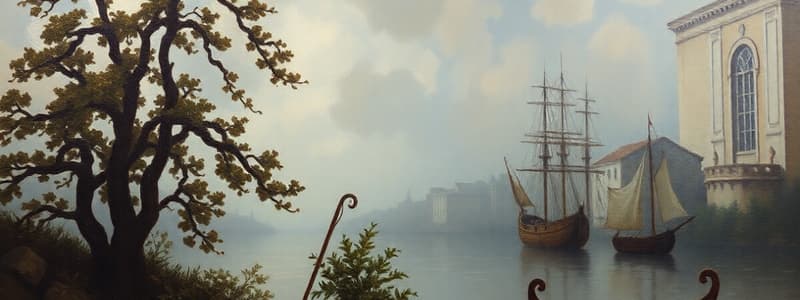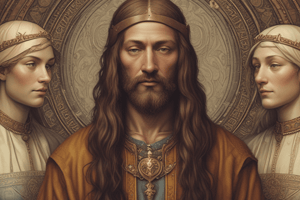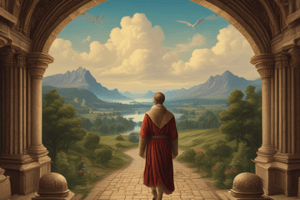Podcast
Questions and Answers
How did the political structure of Italy contribute to the flourishing of the Renaissance?
How did the political structure of Italy contribute to the flourishing of the Renaissance?
- Alliances between city-states led to a standardized artistic style, promoting widespread appeal.
- The unified central government provided consistent funding for the arts across the peninsula.
- The Papal States' dominance ensured religious themes were prominent in artistic expression.
- Fragmented city-states fostered competition and innovation in arts and culture. (correct)
What was the most significant way that urbanization influenced the Renaissance?
What was the most significant way that urbanization influenced the Renaissance?
- Urban planning initiatives led to the development of new architectural techniques.
- Urban centers became hubs where artists, scholars, and thinkers exchanged ideas and collaborated. (correct)
- The concentration of religious institutions in cities standardized artistic themes.
- Cities provided the agricultural surplus needed to feed artists and scholars.
Which of the following scenarios best exemplifies the role of patronage during the Renaissance?
Which of the following scenarios best exemplifies the role of patronage during the Renaissance?
- The Church mandates specific artistic guidelines to ensure religious orthodoxy in art.
- City governments impose taxes to fund public art projects that glorify civic achievements.
- A wealthy banking family commissions a series of paintings and sculptures to decorate their palace and sponsors young artists. (correct)
- A guild of painters collectively decides on the themes and styles for public artworks.
How did the decline of feudalism contribute to the conditions necessary for the Renaissance?
How did the decline of feudalism contribute to the conditions necessary for the Renaissance?
What role did technological innovations play in the spread and impact of the Renaissance?
What role did technological innovations play in the spread and impact of the Renaissance?
Which factor was LEAST influential in the emergence of the Renaissance in Italy?
Which factor was LEAST influential in the emergence of the Renaissance in Italy?
How did Renaissance humanism MOST significantly diverge from medieval scholasticism?
How did Renaissance humanism MOST significantly diverge from medieval scholasticism?
Which advancement is LEAST representative of the scientific achievements during the Renaissance?
Which advancement is LEAST representative of the scientific achievements during the Renaissance?
In what way did the patronage system MOST influence the development of Renaissance art?
In what way did the patronage system MOST influence the development of Renaissance art?
Which statement BEST encapsulates the long-term impact of the Renaissance on European society?
Which statement BEST encapsulates the long-term impact of the Renaissance on European society?
How did the development of the printing press MOST profoundly impact the spread of Renaissance ideas?
How did the development of the printing press MOST profoundly impact the spread of Renaissance ideas?
How did Renaissance exploration MOST fundamentally reshape European understanding of the world?
How did Renaissance exploration MOST fundamentally reshape European understanding of the world?
Which Renaissance literary work is PRIMARILY concerned with political philosophy rather than artistic expression or personal introspection?
Which Renaissance literary work is PRIMARILY concerned with political philosophy rather than artistic expression or personal introspection?
How did the Renaissance contribute to setting the stage for the Enlightenment?
How did the Renaissance contribute to setting the stage for the Enlightenment?
Which of the following best encapsulates Niccolò Machiavelli's primary contribution to political thought during the Renaissance?
Which of the following best encapsulates Niccolò Machiavelli's primary contribution to political thought during the Renaissance?
What distinguishes the Northern Renaissance from the Italian Renaissance?
What distinguishes the Northern Renaissance from the Italian Renaissance?
How did the invention of the printing press by Johannes Gutenberg impact the spread of Renaissance ideas?
How did the invention of the printing press by Johannes Gutenberg impact the spread of Renaissance ideas?
Which of the following best describes the concept of 'virtue' as presented in Baldassare Castiglione's The Book of the Courtier?
Which of the following best describes the concept of 'virtue' as presented in Baldassare Castiglione's The Book of the Courtier?
How did Renaissance patronage influence the artistic and intellectual output of the period?
How did Renaissance patronage influence the artistic and intellectual output of the period?
What role did the rediscovery of classical texts play in shaping Renaissance thought and culture?
What role did the rediscovery of classical texts play in shaping Renaissance thought and culture?
Which of the following best describes the impact of Renaissance inventions on European society?
Which of the following best describes the impact of Renaissance inventions on European society?
How did the development of perspective in Renaissance art contribute to a shift in artistic representation?
How did the development of perspective in Renaissance art contribute to a shift in artistic representation?
What factors contributed to the decline of the Renaissance in the late 16th and early 17th centuries?
What factors contributed to the decline of the Renaissance in the late 16th and early 17th centuries?
How did the Renaissance challenge the prevailing medieval worldview?
How did the Renaissance challenge the prevailing medieval worldview?
Which of the following best describes the significance of the Renaissance concept of individualism?
Which of the following best describes the significance of the Renaissance concept of individualism?
How did Renaissance art contribute to the development of realism in visual representation?
How did Renaissance art contribute to the development of realism in visual representation?
How did the Renaissance contribute to the Scientific Revolution?
How did the Renaissance contribute to the Scientific Revolution?
In what ways did the rediscovery of classical texts during the Renaissance influence the development of humanism?
In what ways did the rediscovery of classical texts during the Renaissance influence the development of humanism?
Flashcards
The Renaissance
The Renaissance
A period of transition from the Middle Ages to modernity in Europe (15th-16th centuries).
Renaissance Characteristics
Renaissance Characteristics
Renewed interest in classical antiquity, humanism, and advancements in art, literature, and science.
Humanism
Humanism
An intellectual movement emphasizing human potential and achievements, study of classical literature, rhetoric, and history.
Renaissance Origins
Renaissance Origins
Signup and view all the flashcards
Renaissance Art
Renaissance Art
Signup and view all the flashcards
Renaissance Literature
Renaissance Literature
Signup and view all the flashcards
Renaissance Science
Renaissance Science
Signup and view all the flashcards
Renaissance Exploration
Renaissance Exploration
Signup and view all the flashcards
Economic Growth
Economic Growth
Signup and view all the flashcards
Patronage of the Arts
Patronage of the Arts
Signup and view all the flashcards
Urbanization
Urbanization
Signup and view all the flashcards
Decline of Feudalism
Decline of Feudalism
Signup and view all the flashcards
Technological Innovations
Technological Innovations
Signup and view all the flashcards
Secularism
Secularism
Signup and view all the flashcards
Individualism
Individualism
Signup and view all the flashcards
Classicism
Classicism
Signup and view all the flashcards
Realism
Realism
Signup and view all the flashcards
Perspective
Perspective
Signup and view all the flashcards
Patronage
Patronage
Signup and view all the flashcards
Printing Press
Printing Press
Signup and view all the flashcards
Leonardo da Vinci
Leonardo da Vinci
Signup and view all the flashcards
Michelangelo
Michelangelo
Signup and view all the flashcards
Raphael
Raphael
Signup and view all the flashcards
Niccolò Machiavelli
Niccolò Machiavelli
Signup and view all the flashcards
William Shakespeare
William Shakespeare
Signup and view all the flashcards
Nicolaus Copernicus
Nicolaus Copernicus
Signup and view all the flashcards
Erasmus
Erasmus
Signup and view all the flashcards
Study Notes
- The Renaissance was a period in European history marking the transition from the Middle Ages to modernity and covering the 15th and 16th centuries.
Characteristics
- The Renaissance is characterized by a revival of interest in classical antiquity.
- There was a rise in humanist philosophy, emphasizing human agency and potential.
- Significant advancements were made in art, literature, and science.
- Exploration and discovery expanded the known world.
Origins
- The Renaissance began in Italy in the late Middle Ages.
- Factors contributing to its emergence include the rediscovery of classical texts, economic growth, and the patronage of wealthy families like the Medici.
- The decline of feudalism and the rise of city-states also played a role.
Humanism
- Humanism was a central intellectual movement of the Renaissance.
- It emphasized the study of classical literature, rhetoric, and history.
- Humanists believed in the importance of human reason and individualism.
- Prominent humanists include Petrarch, Erasmus, and Thomas More.
Art
- Renaissance art saw a shift from the stylized religious art of the Middle Ages to more realistic and naturalistic depictions.
- Artists like Leonardo da Vinci, Michelangelo, and Raphael created masterpieces that showcased human anatomy, perspective, and emotion.
- Patronage from wealthy individuals and institutions supported artistic innovation.
Literature
- Renaissance literature was influenced by classical models and humanist ideals.
- Writers like William Shakespeare, Niccolò Machiavelli, and Baldassare Castiglione produced works that explored human nature, politics, and society.
- The development of the printing press facilitated the spread of literature and ideas.
Science
- The Renaissance witnessed a renewed interest in scientific inquiry and experimentation.
- Scientists like Nicolaus Copernicus, Galileo Galilei, and Isaac Newton made groundbreaking discoveries in astronomy, physics, and mathematics.
- The scientific method, emphasizing observation and experimentation, began to take shape.
Exploration
- The Renaissance was a time of exploration and discovery.
- European explorers like Christopher Columbus, Vasco da Gama, and Ferdinand Magellan charted new sea routes and lands.
- These voyages expanded European knowledge of the world and led to increased trade and colonization.
Impact
- The Renaissance had a profound impact on European culture, politics, and society.
- It led to a flowering of creativity and innovation in art, literature, and science.
- The Renaissance helped to shape the modern world by promoting individualism, secularism, and critical thinking.
- The Renaissance paved the way for the Reformation, the Scientific Revolution, and the Enlightenment.
Key Figures
- Leonardo da Vinci: A true Renaissance man, excelling as a painter, sculptor, architect, scientist, inventor, and more; known for works like the Mona Lisa and The Last Supper.
- Michelangelo: A sculptor, painter, and architect, famous for the David statue, the Sistine Chapel ceiling, and his work on St. Peter's Basilica.
- Raphael: A painter and architect known for his frescoes, including The School of Athens, which embodies the classical spirit of the Renaissance.
- Niccolò Machiavelli: A political philosopher and writer, known for The Prince, a treatise on political power and statecraft.
- William Shakespeare: An English playwright, poet, and actor, considered one of the greatest writers in the English language, known for plays like Hamlet, Romeo and Juliet, and Macbeth.
- Donatello: An early Renaissance sculptor, known for his bronze David, which was one of the first free-standing nude sculptures since antiquity.
- Sandro Botticelli: A painter of the early Renaissance, known for The Birth of Venus and Primavera, which feature mythological subjects and elegant figures.
- Jan van Eyck: An early Netherlandish painter credited with perfecting the technique of oil painting, known for works like the Ghent Altarpiece and The Arnolfini Portrait.
- Johannes Gutenberg: A German goldsmith and printer who introduced the printing press to Europe, revolutionizing the spread of knowledge and literacy.
- Martin Luther: A German theologian and key figure in the Protestant Reformation, who challenged the authority of the Catholic Church and advocated for religious reform.
- John Calvin: A French theologian and pastor who developed Calvinism, a major branch of Protestantism that emphasized predestination and the sovereignty of God.
- Galileo Galilei: An Italian astronomer, physicist, and engineer who made significant contributions to the scientific revolution, including improvements to the telescope and support for heliocentrism.
- Nicolaus Copernicus: A Polish astronomer who formulated the heliocentric model of the universe, which placed the Sun rather than the Earth at the center of the solar system.
- Erasmus: A Dutch humanist, theologian, and scholar who advocated for religious tolerance and reform, and produced a critical edition of the Greek New Testament.
- Thomas More: An English lawyer, social philosopher, and writer, known for his book Utopia, which describes an ideal society based on reason and justice.
- Baldassare Castiglione: An Italian courtier, diplomat, and writer, known for The Book of the Courtier, which describes the ideal qualities of a Renaissance courtier.
- Petrarch: An Italian scholar and poet, considered the father of humanism, known for his sonnets and his rediscovery of classical texts.
Spread of the Renaissance
- The Renaissance spread from Italy to other parts of Europe, including France, England, Spain, and the Netherlands.
- Different regions adapted Renaissance ideas and styles to their own cultural contexts.
- The Northern Renaissance, for example, was characterized by a greater emphasis on religious piety and social reform.
Decline
- The Renaissance gradually declined in the late 16th and early 17th centuries.
- Factors contributing to its decline include the rise of religious conflicts, the centralization of political power, and the emergence of new artistic and intellectual movements, such as the Baroque and the Scientific Revolution.
- However, the legacy of the Renaissance continued to shape European culture and thought for centuries to come.
Key Concepts
- Classicism: The revival of interest in the art, literature, and philosophy of ancient Greece and Rome.
- Humanism: An intellectual movement that emphasized human potential and achievements.
- Individualism: The belief in the importance of individual self-expression and achievement.
- Secularism: The separation of religious and political authority.
- Realism: The depiction of subjects in a naturalistic and lifelike manner.
- Perspective: A technique used to create the illusion of depth and space in art.
- Patronage: The financial support of artists and intellectuals by wealthy individuals and institutions.
Renaissance Inventions
- Printing Press: Invented by Johannes Gutenberg around 1440, revolutionized the spread of knowledge and literacy by allowing for the mass production of books, making information more accessible to a wider audience.
- Improved Eyeglasses: The invention of improved eyeglasses in the late 13th century and their subsequent refinement during the Renaissance greatly aided scholars, readers, and craftsmen, contributing to intellectual and artistic pursuits.
- Firearms: The development of firearms during the Renaissance, including cannons and arquebuses, transformed warfare and military tactics, leading to new strategies and fortifications.
- Mechanical Clock: The refinement of the mechanical clock during the Renaissance improved timekeeping accuracy and reliability, impacting daily life, trade, and scientific observation.
- Mariner's Compass: The continued development and use of the mariner's compass during the Renaissance facilitated navigation and exploration, enabling sailors to chart new courses and discover distant lands.
- Architectural Innovations: Renaissance architects developed new techniques and designs, such as the dome, the arch, and the use of classical orders, leading to grander and more aesthetically pleasing buildings.
Causes of the Renaissance
- Revival of Classical Learning: The rediscovery and study of ancient Greek and Roman texts and art sparked a renewed interest in classical culture and values, inspiring new artistic, literary, and philosophical ideas.
- Economic Growth: The growth of trade and commerce in Italian city-states like Florence and Venice led to increased wealth and prosperity, providing the resources needed to support artistic and cultural endeavors.
- Patronage of the Arts: Wealthy merchants, bankers, and rulers, such as the Medici family in Florence, became patrons of the arts, commissioning works from artists and providing them with financial support and recognition.
- Urbanization: The growth of cities in Europe created centers of intellectual and cultural exchange, where artists, scholars, and thinkers could come together to share ideas and collaborate on projects.
- Decline of Feudalism: The decline of feudalism and the rise of centralized states created a more stable and secure environment, allowing for greater cultural and economic development.
- Technological Innovations: The invention of the printing press and other technological innovations made it easier to disseminate knowledge and ideas, contributing to the spread of Renaissance culture.
- Political Fragmentation of Italy: The political fragmentation of Italy into competing city-states fostered a spirit of competition and innovation, as each city-state sought to outdo the others in terms of artistic and cultural achievements.
Studying That Suits You
Use AI to generate personalized quizzes and flashcards to suit your learning preferences.




